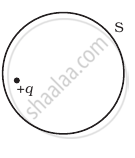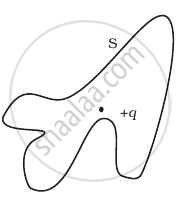Advertisements
Advertisements
प्रश्न
A charge Q is placed at the centre of a cube. Find the flux of the electric field through the six surfaces of the cube.
उत्तर
ccording to Gauss's Law, flux passing through any closed surface is equal to `1/∈_0` tin the charge enclosed by that surface.
`=> phi = "q"/∈_0,`
where ϕ is the flux through the closed surface and q is the charge enclosed by that surface.
The charge is placed at the centre of the cube and the electric field is passing through the six surfaces of the cube.vSo, we can say that the total electric flux passes equally through these six surfaces .
Thus, flux through each surface,
`phi ′ = "Q"/(6∈_0)`
APPEARS IN
संबंधित प्रश्न
State and explain Gauss’s law.
A charge ‘q’ is placed at the centre of a cube of side l. What is the electric flux passing through each face of the cube?
Draw a graph of electric field E(r) with distance r from the centre of the shell for 0 ≤ r ≤ ∞.
State Gauss’s law for magnetism. Explain its significance.
Answer the following question.
State Gauss's law on electrostatics and drive expression for the electric field due to a long straight thin uniformly charged wire (linear charge density λ) at a point lying at a distance r from the wire.
Gaussian surface cannot pass through discrete charge because ____________.
The surface considered for Gauss’s law is called ______.
Gauss' law helps in ______
The Electric flux through the surface
 (i) |
 (ii) |
 (iii) |
 (iv) |
Five charges q1, q2, q3, q4, and q5 are fixed at their positions as shown in figure. S is a Gaussian surface. The Gauss’s law is given by `oint_s E.ds = q/ε_0`
Which of the following statements is correct?
If there were only one type of charge in the universe, then ______.
- `oint_s` E.dS ≠ 0 on any surface.
- `oint_s` E.dS = 0 if the charge is outside the surface.
- `oint_s` E.dS could not be defined.
- `oint_s` E.dS = `q/ε_0` if charges of magnitude q were inside the surface.
Consider a region inside which there are various types of charges but the total charge is zero. At points outside the region
- the electric field is necessarily zero.
- the electric field is due to the dipole moment of the charge distribution only.
- the dominant electric field is `∞ 1/r^3`, for large r, where r is the distance from a origin in this region.
- the work done to move a charged particle along a closed path, away from the region, will be zero.
If the total charge enclosed by a surface is zero, does it imply that the elecric field everywhere on the surface is zero? Conversely, if the electric field everywhere on a surface is zero, does it imply that net charge inside is zero.
The region between two concentric spheres of radii a < b contain volume charge density ρ(r) = `"c"/"r"`, where c is constant and r is radial- distanct from centre no figure needed. A point charge q is placed at the origin, r = 0. Value of c is in such a way for which the electric field in the region between the spheres is constant (i.e. independent of r). Find the value of c:
A charge Q is placed at the centre of a cube. The electric flux through one of its faces is ______.
